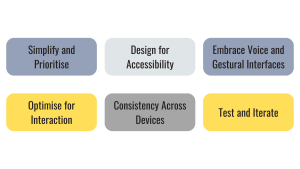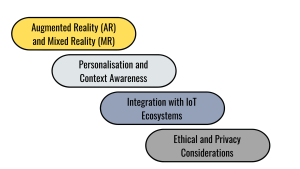content
UI/UX design
February 21, 2024
6 min read
Introduction
The way we interact with devices is constantly changing. From smartphones to wearables, and even smart TVs, the demand for seamless and intuitive user experiences (UI/UX) has never been higher. As we venture into the realm of emerging devices, such as augmented reality (AR) glasses and voice-controlled interfaces, designers and developers face unique challenges in creating interfaces that are both functional and user-friendly.
In this article, we will delve into the world of adapting UI/UX for wearables, smart TVs, and other emerging devices, exploring the key considerations, best practices, and future trends shaping this dynamic field.
Understanding the UI/UX Unique Challenges
Each device category comes with its own set of challenges when it comes to UI/UX design. Wearables, for example, have limited screen real estate, which requires designers to prioritise essential information and interactions. Smart TVs, on the other hand, often involve navigating a large interface from a distance, posing challenges in readability and usability.
- Wearables: With wearables such as smartwatches and fitness trackers, the focus is on delivering glanceable information and quick interactions. Designers must consider factors such as screen size, input methods (touch, gestures), and the context in which the device will be used (e.g., during workouts or while commuting).
- Smart TVs: Smart TVs offer a different user experience compared to traditional television sets. Users interact with them using remote controls or voice commands, necessitating a design that is easy to navigate from a distance and legible on large screens. Additionally, the diversity of content available on smart TVs adds complexity to the UI design, requiring intuitive navigation and content discovery mechanisms.
- Emerging Devices: AR glasses, voice-controlled devices, and other emerging technologies introduce new paradigms for UI/UX design. These devices often blur the line between the physical and digital worlds, presenting opportunities for innovative interaction models but also posing challenges in terms of privacy, accessibility, and user comfort.
Best Practices for Adapting UI/UX
Despite the challenges, several best practices can help designers create compelling UI/UX for wearables, smart TVs, and other emerging devices.

- Simplify and Prioritise: Given the limited screen space of wearables, prioritise essential information and actions. Use clear visual hierarchy and concise language to convey information quickly and effectively.
- Optimise for Interaction: Design intuitive gestures and interactions that are tailored to the device’s form factor and input methods. Consider the ergonomics of wearables and the accessibility of smart TV remote controls when designing interactions.
- Design for Accessibility: Ensure that the UI is accessible to users with diverse abilities, including those with visual or motor impairments. Provide options for customisation, such as adjustable font sizes and colour contrast settings.
- Consistency Across Devices: Maintain consistency in design elements and interactions across different devices to create a cohesive user experience. Users should be able to seamlessly transition between their smartphone, wearable, smart TV, and other devices without encountering unfamiliar interfaces.
- Embrace Voice and Gestural Interfaces: Leverage voice commands and gestures to enhance the user experience, particularly in hands-free or distance-based interactions. Design natural language processing (NLP) algorithms and gesture recognition systems that are responsive and accurate.
- Test and Iterate: Conduct usability testing with target users to gather feedback and iterate on the design. Pay attention to how users interact with the interface in real-world scenarios and make adjustments accordingly.
Future UI/UX Trends and Considerations
Looking ahead, several trends are shaping the future of UI/UX design for wearables, smart TVs, and emerging devices.

- Augmented Reality (AR) and Mixed Reality (MR): As AR glasses and MR headsets become more widespread, designers will need to explore new ways of integrating digital content into the user’s physical environment. This includes designing intuitive spatial interfaces and seamless transitions between the virtual and real worlds.
- Personalisation and Context Awareness: AI-driven personalisation algorithms will enable devices to adapt their UI/UX based on user preferences, behaviour patterns, and environmental context. This will require designers to design flexible interfaces that can accommodate dynamic content and user profiles.
- Integration with IoT Ecosystems: Wearables, smart TVs, and other devices will increasingly become part of interconnected ecosystems powered by the Internet of Things (IoT). Designers will need to consider how these devices interact with each other and with other IoT-enabled devices in the user’s environment.
- Ethical and Privacy Considerations: As devices become more pervasive in our daily lives, designers must prioritise user privacy and data security. This includes transparent data collection practices, granular privacy controls, and safeguards against unauthorised access.
Conclusion
Adapting UI/UX for wearables, smart TVs, and other emerging devices requires a deep understanding of the unique characteristics and challenges of each device category. By following best practices, embracing new interaction paradigms, and staying abreast of emerging trends, designers can create user experiences that are both intuitive and immersive, paving the way for a more connected and accessible digital future.
If you have any questions or an idea for a project, contact us via sales@instandart.com or fill out the form on the main page of the site to discuss.
